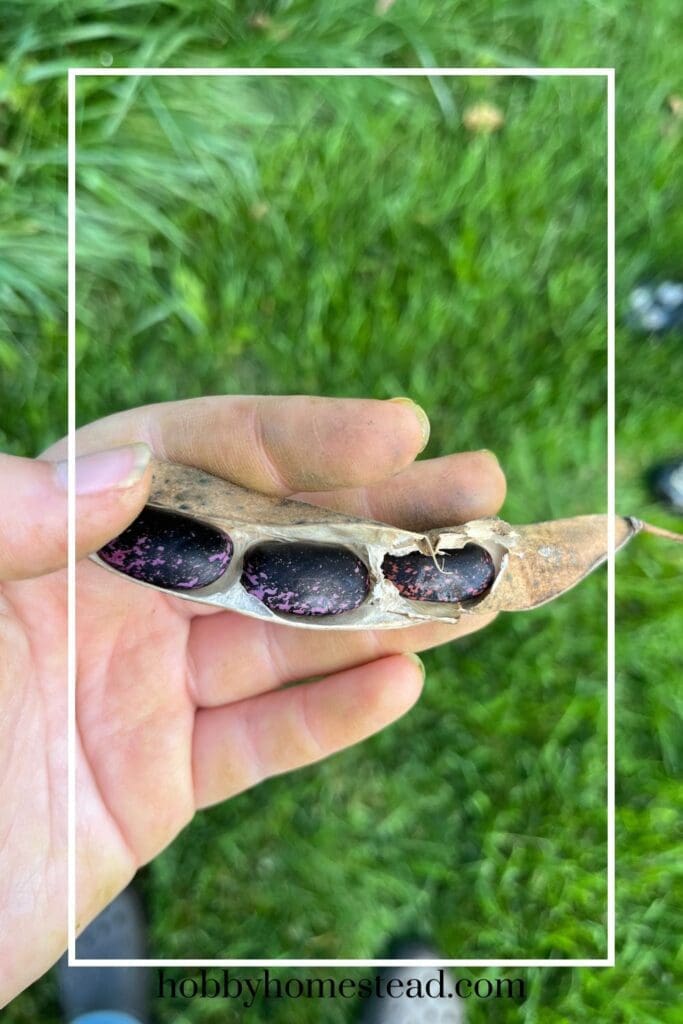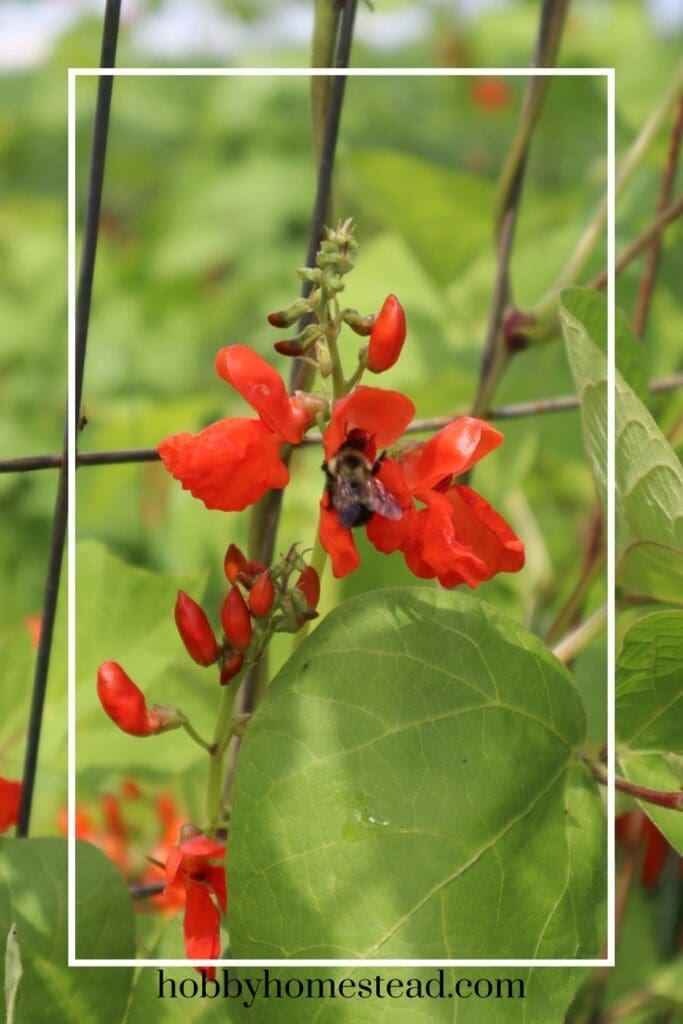How to plant and care for scarlet runner beans. Scarlet runner beans are cherished by gardeners for more than just their striking red flowers. Their bright blossoms attract pollinators, while the edible pods and mature beans provide a tasty harvest.
These vigorous climbing plants also offer several advantages over regular pole beans, and with dozens of cultivars to choose from, there’s a variety to suit almost any garden or homestead.

My First Year Growing Runner Beans
I had never even heard of scarlet runner beans until this year, when a friend handed me a handful. We jokingly called them the magic beans the whole growing season.
Neither of us had any idea what these seeds would look like once they sprouted. How tall they would grow, or that they would produce some of the brightest red flowers I’ve ever seen on an edible plant. They are beautiful when growing!
As the runner bean vines stretched higher each week,
Scarlet runner beans
After some research, I realized we were growing a variety once treasured in Central America and still beloved worldwide for its beauty, versatility, and long growing season.
Scarlet runner beans, also known as scarlet emperor or p. vulgaris types, offer both ornamental value and practical food production. With their long vines, edible pods, and later dry beans, these plants are a great way to add color, height, and harvest potential to any homestead garden.
Why Grow Scarlet Runner Beans?
Scarlet runner bean plants are unlike regular pole beans or bush beans. They offer:
- Vigorous growth with long vines reaching 8–12 feet
- Tuborous roots that sometimes overwinter in warmer climates
- Green pods you can enjoy as tender string beans in early summer
- Edible immature seeds similar to lima beans or fava beans
- Large dry beans that resemble black beans or the variety called Black Knight
- A long period of flowering that draws hummingbirds, bees, and butterflies
- Dozens of varieties, including heirloom and modern varieties
- Higher resilience in cooler temperatures, compared to many types of beans
These aren’t your typical Blue Lake, Kentucky Wonder, or regular green beans. In fact, if you grow several types of beans already, scarlet runners will feel like a whole new experience. Somewhere between growing ornamental vines and cultivating a food crop.

Important Safety Note About Eating Scarlet Runner Beans
While scarlet runner beans are a delicious and versatile edible plant, it’s important to handle them correctly. Do not eat raw mature beans, as they contain small amounts of naturally occurring toxins that can cause digestive upset.
These toxins are completely neutralized by cooking, so always boil, steam, or simmer mature beans before eating. Young green pods and immature seeds are safe to eat when cooked lightly, but the mature dry beans must always be cooked thoroughly to enjoy their full flavor safely.
Taking this simple step ensures your harvest is both delicious and safe for the whole family.
Ideal Conditions for Growing
For best results, scarlet runner beans thrive in well-drained soil rich in organic matter. Since they dislike cold soil, wait until the soil temperature reaches at least 50–60°F.
Sunlight & Soil
- Choose a sunny spot or sunny location with 6–8 hours of direct sun
- Ensure moist soil but avoid soggy areas
- Add compost to boost structure and nutrients
- Avoid using too much fertilizer. Especially too much nitrogen, which leads to vigorous leaves but fewer pods
Temperature & Timing
The best time to plant depends on your climate zone, but in general:
- Late April in warmer climates
- Late May or early June in northern regions
- Always wait until the last frost and the danger of frost has passed
- Cold soil slows germination, and planting before the risk of frost can stunt the seedling stage
These beans also prefer milder days; hot weather and especially hot days over 95°F may slow flowering.

How to Plant Scarlet Runner Bean Seeds
Scarlet runner bean seeds are large, beautiful, and easy to handle. Excellent for children or beginners.
Steps for Planting
- Soak seeds overnight for quicker germination (optional but helpful).
- Plant seeds 1–1.5 inches deep, spacing them 6 inches apart.
- Place seeds carefully under the soil surface in single rows or a single layer under teepees.
- Water gently to maintain soil moisture.
Because these are climbing beans, they need good support. Some great ways to support the vines include:
- Bamboo canes tied into teepees
- Fences
- Arbors
- Trellises
These supports help the plants stand strong during strong winds and keep the bean pods off the ground.
Caring for Scarlet Runner Bean Plants
Runner beans don’t require much time or fuss once established, especially under ideal conditions.
Watering
- Keep the soil evenly moist during the life cycle, especially as flowers form.
- Mulch helps retain soil moisture and regulate soil temperature.
Fertilizing
These beans fix nitrogen naturally, so go light on fertilizers. Too much nitrogen encourages foliage but delays bean production.
Training the Vines
Guide the vines up as they climb. They can grow very long and heavy, and training helps prevent breakage.
Harvesting at Every Stage
One of the best things about scarlet runner beans is their versatility. You can harvest:
1. As Fresh String Beans (Green Pods)
Pick pods when young, crisp, and tender. Usually in early summer. These behave much like regular green beans or string beans.
2. As Shelling Beans (Immature Seeds)
Allow the pods to grow larger. Inside, the immature seeds resemble small lima beans or fava beans.
3. As Mature Dry Beans
By late summer to early fall, pods dry and the large, colorful mature beans develop. These are excellent for soups, simmered dishes with olive oil, or winter storage.
Once pods dry near the end of the growing season, remove the seeds and allow them to cure a bit longer before storing.
Seed Saving
Saving seeds from scarlet runner beans is a great way to preserve your favorite variety.
- Leave pods on the vine until they are fully dry.
- Harvest when papery and brittle.
- Store in a cool, dry place.
This is especially helpful if growing unique heirlooms or at higher elevations, where certain varieties thrive especially well.
Common Pests and Diseases
Like all types of beans, scarlet runners have common pests and potential issues to watch for:
Pests
- Spider mites during drought or high humidity
- Mexican bean beetles in certain regions
- Aphids on tender new growth
These pests typically appear in hot weather or stressed conditions. A strong blast of water or organic soap spray is often all you need.
Diseases
- Powdery mildew, especially in late summer
- Fungal disease in wet or crowded areas
- Mosaic virus, which causes mottled leaves
Improving airflow and watering at the soil line help prevent most issues.
Are Scarlet Runner Beans the Same as Other Beans?
Scarlet runner beans are closely related to regular pole beans, but they’re different from:
- Lima beans
- Fava beans
- Black beans
- P. vulgaris bush beans
Runner beans are grown primarily for their flowers, vigorous vines, and multipurpose harvest options. Their parts of the plant, including vines, pods, and seeds, offer more versatility than many garden beans.

Are Scarlet Runner Beans Edible?
Yes! Scarlet runner beans are completely edible at multiple stages of growth:
- Young green pods (string beans). Pick them when they are tender, usually 4–6 inches long. These can be cooked like regular green beans.
- Immature seeds. Allow the pods to swell slightly, and the seeds inside can be shelled and cooked similar to lima beans or fava beans.
- Mature dry beans. Let pods fully dry on the vine, then remove the mature beans. These can be stored and used in soups, stews, or any recipe calling for dry beans.
Important: Do not eat raw mature beans. They contain small amounts of naturally occurring toxins, which are destroyed by cooking. Always cook mature runner beans thoroughly.
Are Scarlet Runner Beans Perennial?
Scarlet runner beans are technically perennial in warmer climates, meaning their tuberous roots can survive mild winters and regrow the following year.
- In cold climates or higher elevations, they are usually grown as annuals, because frost will kill the vines and roots.
- If you live in warmer climates (USDA zones 7–10), you can overwinter the roots indoors or in a protected garden bed and get early growth the next season.
Many gardeners save seeds instead of overwintering the plants, since scarlet runner beans produce dozens of varieties each year and are easy to replant from seed.
Magic Scarlet Runner Beans
Those “magic beans” my friend gave me turned out to be one of the most delightful surprises of my gardening year. What began as a mystery handful of seeds has now become a plant I’ll grow every year for its ornamental value, edible pods, colorful blooms, and generous harvest of dry beans.
If you’re looking for a beautiful edible plant that offers food, pollinator interest, and a bit of whimsy, scarlet runner beans are the best way to add life and color to your homestead garden. They reward you with continuous blooms, a long harvest season, and the chance to grow a crop that connects us to generations of gardeners.
✨⬇️ Step-by-Step Guidance
Copy and paste this into ChatGPT or another AI tool:
I’m following a Hobby Homestead article, https://hobbyhomestead.com/scarlet-runner-beans-planting-and-care-basics/. Summarize the key steps in clear order, including any tools, supplies, or preparations needed, so I can follow along easily.


